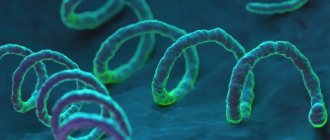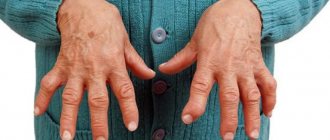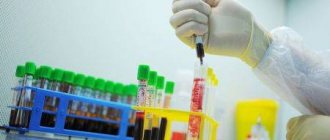Purpose of blood microreaction
The study is not a specific analysis, since it does not aim to find the pathogen. Cell destruction can also occur in other diseases. Therefore, if the test results are determined to be positive, other laboratory tests must be performed.
What does the analysis reveal?
Sexually transmitted diseases are caused by various pathogens. When they enter the body, the immune system responds by increasing the synthesis of substances that should fight them. In response to the multiplication of the pathogen, antibodies are produced that bind it. There should be as many antibodies as there are bacteria.
During the fight, Treponema pallidum or another pathogen destroys the membrane of its own cells. These residues also need to be removed, which is what the antibody responds to.
The analysis shows the presence of such components, their complexes, antibodies and antigens. Each of them can be quantified.
Analysis of urine
Urine testing is a complex laboratory exercise through which a number of chemical and physical characteristics of a given substance are revealed, on the basis of which a specific diagnosis can be made. Due to its ease of implementation and high information content, this analysis is considered an integral part of any diagnosis. Decoding a urine test involves a description based on the following indicators:
- color;
- transparency;
- acidity index and specific gravity.
After this, the presence of specific elements in the urine is assessed, such as:
- glucose;
- protein;
- ketone bodies;
- bile pigments;
- inorganic substances;
- hemoglobin;
- blood cells (red blood cells, white blood cells, etc.), as well as cells that are found in the genitourinary tract.
A study is prescribed in the following cases:
- with an auxiliary study of the functioning of the urinary system;
- when monitoring the development of the disease and checking the quality of their therapy;
- for any diagnosis of pathologies in the body.
Using this analysis, it is possible to diagnose renal disorders, diseases of the prostate gland, bladder, various tumors, as well as a number of pathological phenomena in the early stages, when there are no clinical symptoms.
Types of research
All nonspecific studies can be divided into two large categories: macro- and microreactions. The first is carried out without additional equipment and is assessed visually. The second requires equipment in the form of a high-magnification microscope.
Electron microscopy allows you to identify destroyed cells without the use of a reagent.
There are several types of blood tests for microreactions:
- rapid test with macroscopy;
- classical sediment research;
- quantitation.
The first method does not require examining the material under a microscope; the result is visible to the naked eye.
The essence of the analysis is that the patient’s blood is placed in a centrifuge, serum is obtained, to which a concentrated solution must be added. In the presence of a pathogen, the liquid becomes colored .
In the second method, blood serum is examined under a microscope; no additional substances are used. To obtain a quantitative value, the serum is diluted many times, then sent under a microscope, and the laboratory technician records the number of bound antigen-antibody complexes in the smear.
Results and reliability of research
A false positive or false negative reaction to syphilis is possible under certain conditions. Typically, inaccurate results account for 5% of the total number of tests performed by laboratories. A false negative reaction is possible when the blood contains too few antibodies (early or late syphilis). Perhaps ordering additional studies. A number of factors can cause a false positive reaction.
- Diabetes
- Alcohol or drug addiction
- Diseases of the cardiovascular system (stroke, etc.)
- Infectious diseases (tuberculosis, hepatitis, etc.)
- Presence of tumors, including benign ones
- Recent vaccination or antibiotic use
- Pregnancy
- Autoimmune systemic diseases (arthritis, lupus, etc.)
In some cases, if you have obvious clinical symptoms of syphilis, but receive several negative blood tests, your doctor may order a cerebrospinal fluid test. To obtain the most reliable result, you should inform your doctor about the diseases you have suffered and the medications you are taking. In this case, the doctor will be able to calculate how many days you should wait before the test.
First of all, patients are interested in how often they test for syphilis and when they can learn the result. Depending on the type of research, laboratories equipped with modern equipment provide analysis results quite quickly. The RIF test can be ready within 24 hours; other blood tests take from 2 to 4 days. If the laboratory is very busy, the time for diagnostics increases by several days. District clinics, as a rule, provide test results in 1-2 weeks.
Indications for the study
Due to the simplicity of the study and the absence of the need to use expensive reagents, the microprecipitation reaction is used for large groups of the population, most often during routine examination.
The analysis is scheduled:
- military personnel;
- pregnant women;
- patients before surgery;
- during examination in a prison or pre-trial detention center;
- when examining medical workers and catering staff;
- before donating blood for donation;
- before organ transplantation.
During treatment, to monitor the effectiveness of the prescribed therapy, the study is carried out several times.
The quantitative reaction test is indicated for persons who show signs of pathology, children of sick parents, and for ulcers on the genitals. An examination is also needed to confirm the diagnosis after initial tests or if the patient has other sexually transmitted diseases.
Plasma testing for bladder cancer - what is it?
The abbreviation RMP stands for microprecipitation reaction
. This type of analysis does not belong to the category of treponemal tests - identifying infectious agents.
The research is based on the determination of antibodies that are produced to one of the components of the internal membranes of microorganisms - cardiolipin. The production of these antibodies occurs at the primary stage of syphilis development, when 7 to 10 days have passed since the appearance of external signs of the disease - skin rashes. At the initial stage, this method detects the disease with a probability of up to 80%, and at the secondary stage - up to 97%. With its help, you can almost reliably find out whether there is a source of infection in the patient’s body.
Preparation
To get a reliable result, you must follow the rules for donating blood. There are several important points to consider.
In order not to provoke the release of excess hormones, the examinee must refrain from significant physical activity before blood sampling, from smoking, from alcohol the day before, and from fatty foods.
Blood donation occurs on an empty stomach, since lipids will appear as a film on top of the tube and may distort the result. The last meal should take place the day before at about 19 pm.
How to properly prepare for the analysis?
In order to obtain correct results of the precipitation microreaction when testing for syphilis, a number of conditions must be met for some time before visiting the laboratory. Recommendations for preparing for donating blood for syphilis include the following points:
- Be sure to inform the doctor about all existing concomitant diseases. The presence of certain pathologies may distort the results;
- To get the correct results, give your doctor a list of all medications prescribed by other specialists that you are currently taking. You may need to cancel for a week or make adjustments to the treatment regimen;
- a week before visiting the laboratory, you must stop taking any medications that have antibacterial, antiviral or antifungal effects;
- three days before submitting the material, stop drinking any drinks containing alcohol, even in minimal quantities;
- the day before the study, fatty, spicy, smoked and fried foods are excluded from the diet;
- An hour before the test, you must completely stop smoking.
Blood is donated in the morning on an empty stomach. Until this time, you can only drink pure still water.
With proper preparation for the study, the risk of obtaining false positive results is significantly reduced. Therefore, it is necessary to strictly follow all the recommendations of the attending physician before conducting the study.
Blood sampling for research
For a microreaction, it is necessary to take capillary blood, that is, from a finger. It is subjected to centrifugation, that is, the clot is removed from the formed elements, leaving plasma. Additionally, blood is taken from a vein. If it cannot be taken, then cerebrospinal fluid will do.
The biological material is settled, plasma or serum is mixed with the antigen. At the same time, the progress of the reaction is assessed. The healthcare professional should monitor the fluid for signs of discoloration.
How long is a blood microreaction test valid?
Venous blood shows the presence of traces of the pathogen within 3-4 weeks after infection. The shelf life of the test depends on its purpose and the standards of the medical institution.
- During treatment, the outcome of the reaction is assessed every few weeks.
- The validity of the test for medical workers with a negative result is 12 months.
- After contact with a potentially sick person, it is necessary to conduct a test a month later, regardless of how long ago the previous study was carried out.
What is RW
For many patients, doctors prescribe blood donation for RW. The analysis is mandatory, so it is prescribed to healthy patients who come to a medical facility with symptoms of an infectious disease or are admitted to a hospital for treatment. The shelf life of the results is no more than 30 days if the person has no signs of infection. This type of diagnosis has been used for more than a century since the famous German immunologist proposed it to detect syphilis.
Modern doctors take blood for RW to identify an infection in a person, and this does not depend on the reason for the patient’s visit to the hospital. What is the Wasserman reaction? This is a rapid blood test in which material taken from the patient is tested with a special antigen. The RW test gives a positive result when nonspecific antibodies enter into a microreaction with lipids.
Decoding the result
While telling what it is - a blood microreaction, it is also necessary to mention how the results are deciphered. It may imply a negative, positive or dubious outcome.
Sometimes a false positive or false negative result is determined. The reasons for this phenomenon will be discussed below.
Positive result
This reaction is observed if flakes are found on the slide. This means that the serum contains antibodies that were produced against antigen fragments or cells destroyed by them.
The “+” result can be observed for a long time even after treatment, since it takes a considerable period to cleanse the blood of all fragments of treponemes and the remains of destroyed cells. But the antigen titer will make little difference.
A positive reaction may indicate that the patient has syphilis, has acquired seroresistance, or has residual effects after therapy. There are also false positive results.
What will the analysis tell you?
What is RMP analysis? The result of a blood test is a certain reaction to antibodies. After the RMP, a transcript of the analysis is made, which tells whether the person has syphilis.
Blood test for bladder cancer, its decoding and accuracy. A positive reaction indicates the presence of the pathogen in the body. After receiving this result, the doctor will prescribe additional tests for the patient to clarify the stage of the disease and other aspects on which further therapy will depend.
However, the reaction may also be positive in patients who do not have syphilis. Such a false positive result sometimes occurs when the patient has a disease from the following list:
- malignant neoplasms,
- diabetes,
- HIV infection,
- chlamydia,
- infectious disease: measles, scarlet fever, chicken pox, malaria, leptospirosis, atypical pneumonia, leprosy,
- rheumatic pathologies: rheumatoid arthritis, scleroderma, gout,
- tumor diseases of the lymphatic and circulatory systems,
- active stage of tuberculosis or progressive tuberculosis,
- viral hepatitis,
- microplasma infection,
- autoimmune diseases: lupus erythematosus, thyroiditis and others.
It is extremely rare that the number of antibodies can exceed the norm in elderly people who are not carriers of Treponema pallidum. And among pregnant women, the rate of false positive results can reach 28%.
A negative reaction in most cases indicates that the person does not have syphilis.
However, given that the body begins to produce antibodies to the causative agent of the disease no earlier than a week after the formation of chancre, the reaction of blood taken before 4-5 weeks from the moment of contact with the carrier may turn out to be negative even if infection does occur . What does this mean in our case? The fact that there is a certain error in the study, and in some patients the disease is not detected by the study of bladder cancer. In addition, the same reaction may occur in patients at a later stage of the disease.
How is it carried out?
The microreaction to syphilis is carried out by analyzing blood .
The study is based on the binding of a specific antigen-antibody complex.
In this case, the role of antigen is cardiolipin antigen, antibodies are lipoproteins of body tissues destroyed under the influence of Treponema pallidum and, possibly, components of the cell membrane of the pathogen.
It should be borne in mind that the microreaction to syphilis cannot be used to confirm the disease. This study is only screening, since tissue destruction is accompanied not only by syphilis.
Also a number of other diseases (systemic collagenosis, tuberculosis, etc.).
Therefore, a positive microreaction to syphilis can be observed, including in these cases. This study result cannot be a confirmation of the presence of a syphilitic infection. It only serves as a signal for additional clarifying analyses.
Positive reaction
MR is a serological test used for the purpose of mass screening of the population for syphilis. It is carried out during pregnancy registration, during medical examinations of healthcare workers, education workers, and public caterers.
Also before hospital treatment and surgery, for blood donors and organ transplants.
In addition, MRI is indispensable for the rapid diagnosis of syphilis in people who are in close contact with syphilitic patients.
Also for those whose sexual partner is infected with syphilis.
The microprecipitation reaction is carried out in all patients with ulcerative, erosive, papular rashes on the genitals.
Such an analysis is also necessary to control infection after unprotected sexual contact with casual partners. This is a non-specific, non-treponemal test, so it is only suitable for the initial, express diagnosis of infection.
If the result is positive, specific treponemal seroreactions (ELISA, RPGA) are performed.
Allowing you to accurately verify the diagnosis and confirm the disease.
The microreaction to syphilis makes it possible to diagnose not only qualitatively (for the presence of antibodies to treponema), but also quantitatively - to determine the antibody titer and the intensity of the disease.
Negative reaction
A negative microreaction to syphilis means that there are no antibodies to Treponema pallidum in the patient’s blood and there is no disease.
MR is a study that is used to evaluate the effectiveness of treatment for syphilis.
At the end of a course of specific drug therapy, a microreaction is carried out.
If the result is negative, a conclusion is drawn about the success and effectiveness of the therapy.
If positive, therapy continues, perhaps changing its tactics and choice of drugs.
It is not advisable to use specific treponemal tests to monitor the cure of syphilis.
Since they can remain positive throughout the life of patients, even with their long-term recovery.
You should donate blood for MRI in the morning on an empty stomach; blood is taken from a vein.
The day before, you should refrain from drinking alcohol, fatty, fried and heavy foods.
What is this analysis?
In the body, in response to the introduction of pathogenic microflora or when its own cells are damaged, special protein elements are formed - antibodies. When diagnosing syphilis using the microreaction method (MRP) in the patient’s blood, they try to find the connection between antibodies and phospholipids - proteins that make up all cell membranes.
An immune response in the form of antibody production is formed precisely when phospholipids from cell membranes enter the blood. This occurs when Treponema pallidum, the causative agent of syphilis and a number of other infections, penetrates human tissue.
It takes a certain amount of time for antibodies to begin to be produced when infected with syphilis. This does not happen instantly, but, at the earliest, 3-4 weeks after infection. This is why this test is not suitable for early diagnosis. But due to the ease of implementation and low cost, MRP is classified as a screening test designed to detect the disease among the general population.
Diagnosis of syphilis using this method consists of the following steps:
- preparing the patient for collecting material;
- donating blood in the laboratory. The analysis requires patient blood, which is most often taken from a vein, but in some medical institutions it is also used from a finger;
- using special equipment, blood plasma is separated from cellular elements;
- An antigen with a visualizing agent is added to the resulting biological fluid. Coal is most often used for this;
- If phospholipid antibodies are present in the serum, they stick together with the introduced antigen, which is manifested by the formation of black flakes, indicating a positive reaction. In the absence of antibodies to phospholipids in the body, flakes are not formed.
A quantitative assessment of the presence of Treponema pallidum in the body is also carried out with the calculation of titer indicators. For this purpose, microreactions to syphilis are performed in dilutions. During the research process, the patient's blood serum is diluted with saline solution, first twice, then four times, and so on, each time doubling the dilution and conducting a test to detect antibodies in the material. In this case, the dilution at which the microreaction last remained positive is noted. For example, 1:320 means that even with a dilution of 320 times, the blood serum still contains antibodies. This figure is an indicator of the titer and is indicated in the analysis. The higher the titer value, the more active the pathological process in the body.
Quantitative determination of the titer is important for monitoring the effectiveness of therapy and diagnosing the final cure of syphilis. Within a year after course therapy, there should be a 4-fold drop in titers. Control tests are carried out 3 months, six months and a year after treatment.









